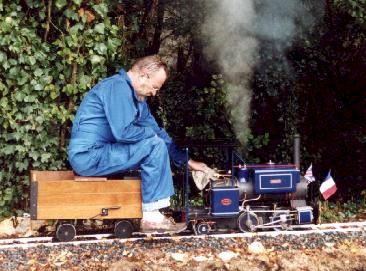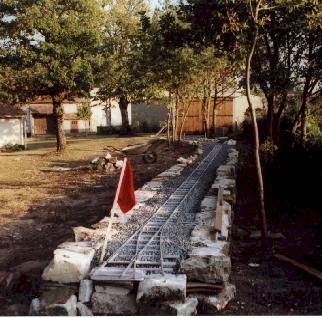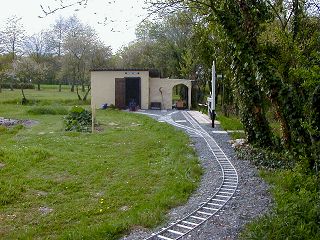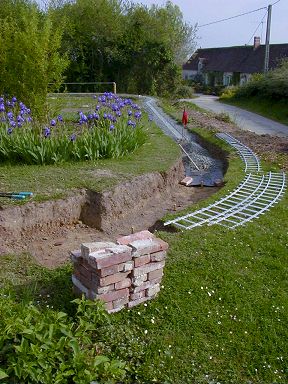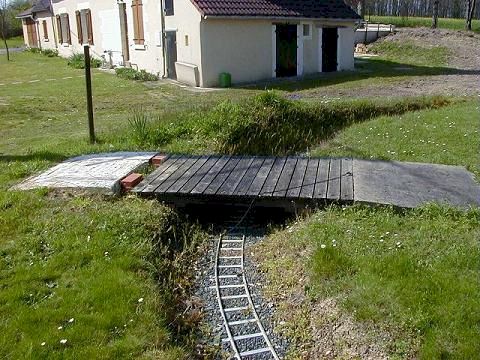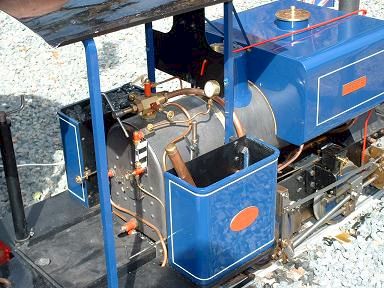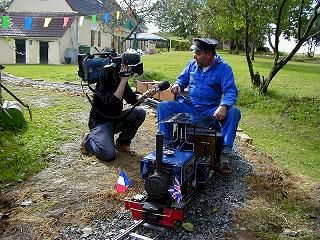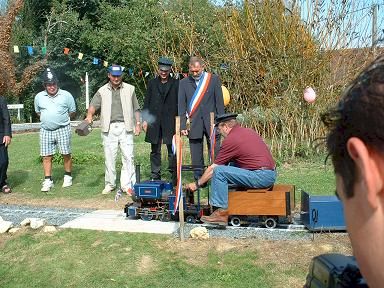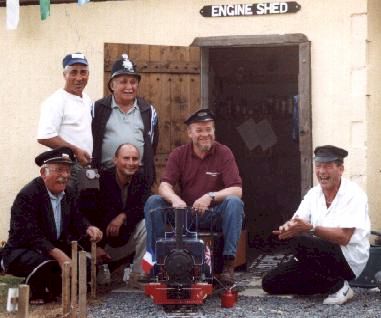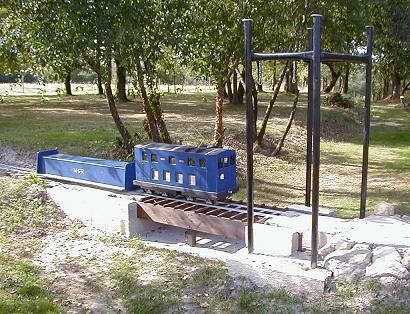Mouline Garden Railway Video (click here): film of the events leading up to and including the opening day
|
|
The Mouline Garden Railway situated near the Touraine (France) town of St Flovier is not finished. The first circuit of 200 metres is up and running and, at least, gives the opportunity for "puffer nutters" of English, French, Irish and Scottish nationalities to play. The second section of about 400 metres in length involves the construction of a lifting railway bridge (now completed|), turntable, second station and second turnaround loop. |
|
|
Construction work started in the autumn of 2001 on the wrong side of the garden. What looked like reasonably level ground over a 100 metre straight stretch turned out to be a massive descent when eventually checked with a laser - in fact at the end of the run the embankment would have reached a height of just over 1 metre. Although about 50ft of track had been laid it had to be torn up and relocated. About five tonnes of stone had already been moved by hand to form the embankment. The lesson to be learned - never trust your eyes!
|
By pure luck an old workshop in the vegetable garden was just big enough to accommodate loco and rolling stock and was converted into an engine shed. An adjacent lean-to became the obligatory tunnel. Here the ground looked level but laser checks revealed the need for an embankment 30 cm high on the station side and a cutting 50 cm deep at the other extremity of the circuit. A loop was constructed opposite the platform for turnarounds in advance of the second section yet to be built. |
|
|
The cutting was hand excavated mainly thanks to the mole-like endeavours of St Flovier`s former adjutant-chef of the gendarmerie, Dominique Riveill, who regarded the whole undertaking as nothing more than good exercise. The cutouts in the embankment mark the position of now constructed brick buttresses which support a wooden lifting bridge across which barrows and a small garden tractor can pass. As the bridge height is only 50cm above the track drivers are reminded to lift the bridge and secure it before moving their trains. Decapitation of either heads or funnels can ruin your entire day. |
Main motive power for the railway comes from a Maxitrak 0-4-2 Pearl saddle tank loco based on the Kerr Stuart industrial engines built during the 1920s. The livery is Caledonian Blue and the engine is named Irene. This powerful loco is easy to fire using a 12V DC blower during the initial stages. Once around 15 psi is reached the steam blower of whiffler can be used to draw the fire to reach a working pressure of 60 psi. Small coal is difficult to find in central France so a mixture of steam coal imported from the UK and hard anthracite grains are used. The boiler is fed from the saddle tank by either a mechanical or hand feed-pump. Additionally there is an injector which draws cold water from a tank housed in the tender. |
|
|
The inaugeration of the railway was planned for September 21st 2002. Thanks to the enthusiasm of friend, neighbour and fellow railway freak, Michel Pouilly, we were visited in advance by a camerman and reporter from Channel M6 television in advance of the opening. Being interviewed in French about the complexities of firing and driving a miniature steam locomotive was more arduous than standing trial for a crime you had not committed. The piece went out on air on September 19th under the heading "Zin Zin" - which means slightly "potty" or eccentric.
|
Around 70 friends and guests turned up for the inaugeration. St Flovier`s mayor, Francis Baisson, cut the ribbon for the official opening and with a few words about Anglo-French co-operation pronounced the only railway within 20km "in service". Hardly Concorde technology but great fun. The railway suffered only one derailment that afternoon thankfully at the hands of Michel Pouilly - the Jacques Villeneuve of the external combustion engine.
|
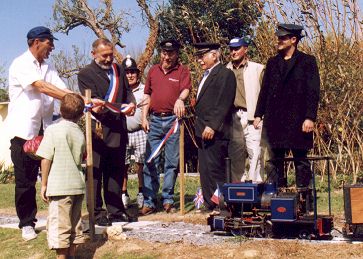
|
|
At the end of an alcoholic day, the French equivalent of Last of the Summer Wine gathered for the final photographs. The array of hats represent "SNCF", "Midland and Great Northern Joint Railway ", "British Railways". "Denver, Colorado and Rio Grande" and, er, Norfolk Constabulary. |
The latest edition to the stock (completed January 2004) is an electric locomotive loosely based on one of the earliest SNCF motive power units - the BB208. Sadly no plans were available so it had to be built using photographs only. The scale of this replica is about 20% shorter in lengrth than the original in order to cope with the sharpest curves on the MGR - about 20ft radius. Powered by a 12V car battery feeding a Maxitrak power bogey and using electronic speed control and braking, it is capable of 6mph. It was given the number - BB209
|
 |
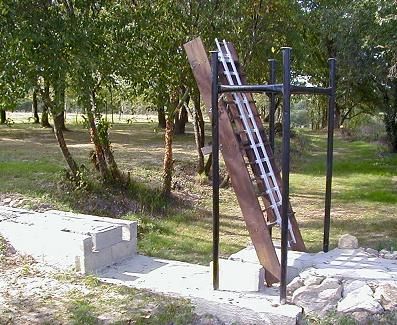
|
For the second circuit it has been necessary to cross an ancient chemin rural, now part of the property. While the height of the track is only 60cm above the old road, constructing a causeway or embankment was out-of-the-question as access was needed for garden tractor and trailer, wheelbarrows and the occasional randonneur. The lifting bridge, completed during the summer of 2004, was built in true Isambard Kingdom Brunel box structure style and hinged well back from the point of contact between rails to avoid snagging. Inner guide rails have been added to ensure smooth transition at the joints. As the lifting part of the bridge was constructed from timber it was necessary to let the assembly "weather" for a few months before final vertical adjustments were carried out. At contact points there is now less than a millimetre vertical error. Various locals dubbed it a pont trop loin while others, noting it was a British design, insisted that miniature Japanese guards should be posted at either end.
|
Apart from regular railway maintenance work, the final construction project for 2004 was a water tower. Costing virtually nothing the tower was constructed from timber offcuts, spare lengths of copper tubing, short lengths of garden hose and spare brass elbows. The water container was modified from an old 30 litre wine container. By using a Hozelock connector the delivery arm can be swung away to the side of the track without any water leaks when either in or out of use. Water tower capacity provides four full fillings for the locomotive`s saddle tank |
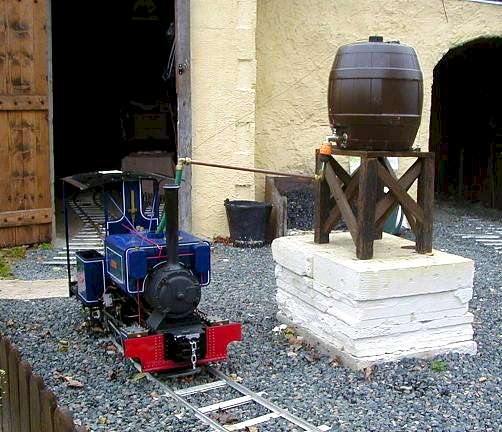 |
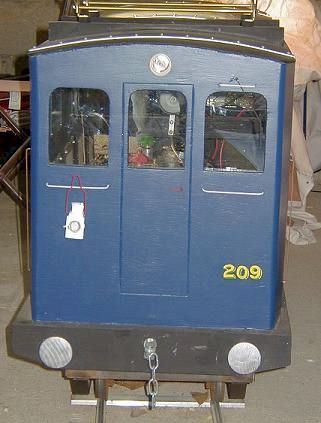 |
Finishing touches were also added to the BB209. These included a working headlight, buffers and grabrails. The headlight was made from a redundant torch which was cut to fit and the 1.5V bulb replaced with a 12V 3W automotive bulb. The buffers were made from 5cm diameter drawer knobs, the faces of which were ground down to give a slight convex shape and painted with Humbrol "steel" paint. The grabrails were fashioned from brazing rods and painted white. Finally the additional loco number of 209 was added using Southern Region scale transfers. All-in-all a melange of British and French bits as the original buffers would have been oblong and no French loco would have sported a BR oil lamp let alone the "sunshine" numerals.
|
Work restarted at the end of 2006 on the longest stretch of track which is planned to connect the lifting bridge to the final station - a total distance of about 350 metres. For this a cutting of more than 100 metres traversing the garden had to be dug - too much for an ageing railway builder to do by hand. Time to call in the big guns in the shape of a mini-digger which saw off the work in a day. A ramped crossing was also excavated to allow for garden machinery and pedestrian access to the garden`s end.
|
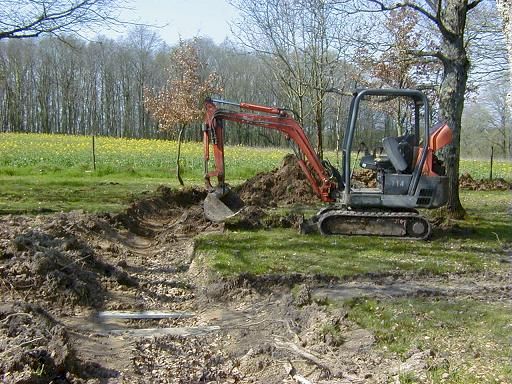 |
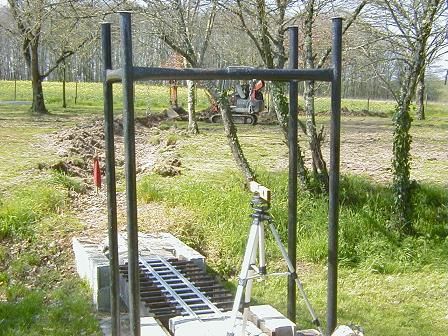
|
The cutting was excavated to a depth of about 30cm below the level of the rails to allow for the addition of plastic sheeting and hardcore as a base. Pegs were driven into the ground at 8ft intervals to determine the finished rail level although there will be some later adjustment as ballast is added. Depths and levels were constantly monitored with both a laser and spirit level. It is worth the effort to avoid excessive fannying around at a later date.
|
For the final fast curve with a radius of 20 metres (roughly 60ft) the track was made up in advance, laid out and marked either side with an aerosol ground marker spray. Various adjustments to the radius had to be made to avoid a number of small trees. Short lengths of straight track facilitated this. In addition the trees prevented easy access with the digger so the edges of the curved cutting will be finished the hard way - with a pick and shovel. |
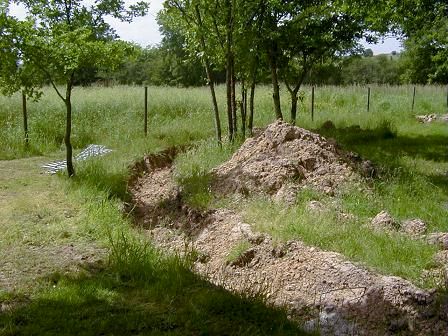 |
